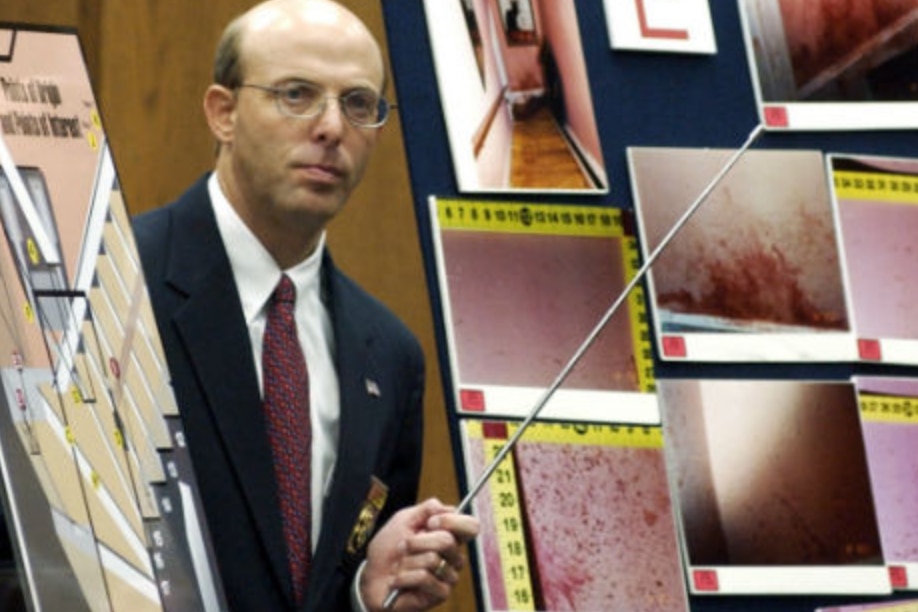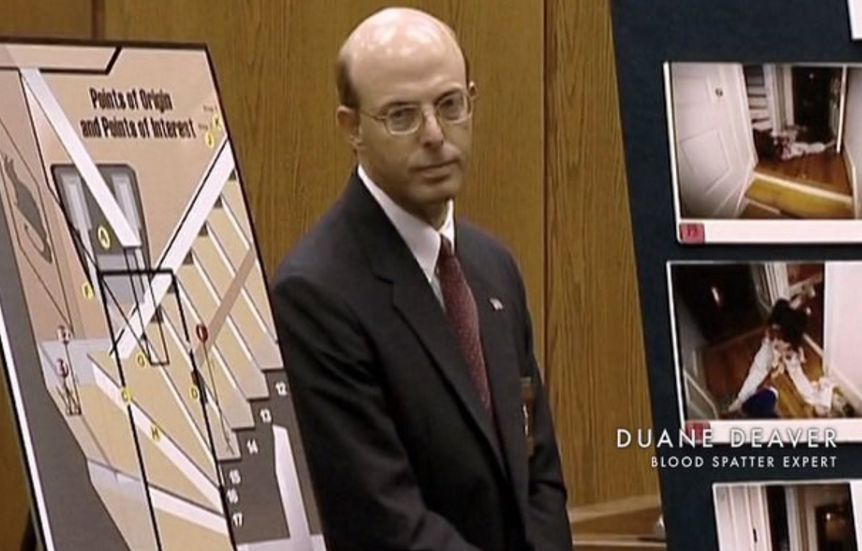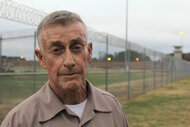Create a free profile to get unlimited access to exclusive videos, breaking news, sweepstakes, and more!
Is Bloodstain Pattern Analysis, Like Testimony Highlighted In Netflix’s 'The Staircase,' Biased?
Bloodstain spatter expert Duane Deaver's testimony helped put author Michael Peterson behind bars. But, when it was revealed that he was negligent and lied on the stand, Peterson got a new trial.

In Netflix’s “The Staircase,” Duane Deaver, a blood spatter analyst who worked for North Carolina’s State Bureau of Investigation, testified that blood stains at the bottom of author Michael Peterson’s staircase revealed that his wife Kathleen died from being beaten to death.
He said the blood on the walls of the stairwell and on both Michael and Kathleen’s clothes proved Michael killed her in 2001 with a blunt object. Peterson was sentenced to life without parole two years later, and Deaver’s testimony played a large role in that conviction.
Later, it was revealed that Deaver committed perjury during Peterson’s 2003 trial by lying about his credentials. His lies led to Peterson receiving a retrial. Deaver was fired from the SBI in 2011 after it was revealed that he falsified evidence in 34 different cases, WRAL reported.
Another case Deaver was involved in is discussed briefly in the latter epsiodes of the “The Staircase.” Kirk Turner was wrongfully convicted of murdering his wife in 2007. He sued Deaver and another SBI agent, which resulted in a $200,000 settlement in 2018, the Winston-Salem Journal reported. Turner’s suit claimed the agents created their own theory of what happened and then created results to match. Turner was also awarded a settlement of $4.25 million from the state of North Carolina.
Deaver also neglected to report blood tests results that would have been helpful to defendant Greg Taylor in an entirely different case. He was convicted of a 1991 murder, and his case also appeared briefly in the documentary. Taylor’s conviction was thrown out as a result of Deaver’s misconduct, but not before Taylor wasted nearly two decades behind bars.
Is bloodstain spatter analysis a biased science, or was Deaver just a bad egg?
“I don’t know one case in America, in spite of what that program says, that has been reversed because of blood patterns,” Rod Englert, a 53-year veteran of law enforcement, based in New York told Oxygen.com.
Englert watched “The Staircase” and said, based upon what he saw in the program alone, it appeared that Deaver didn’t do anything wrong with the bloodstain pattern analysis of the blood located at the Peterson home. “But, what I heard him do: fluffing and huffing his expertise, stating [falsely] that he’s worked on numerous similar cases, that’s wrong. That’s bad. His character is demolished forever.”
Englert has consulted in over 500 criminal and civil death cases in the United States and has testified as a homicide court expert in 26 states, according to his website. He’s worked on bloodstain spatter analysis for nearly fifty years and has consulted on thousands of cases. He told Oxygen that he’s even been deposed by David Rudolf, one of Peterson’s tenacious lawyers in “The Staircase,” for an unrelated case.
“He’s extremely thorough,” Englert said. “He does his homework. Can’t take that away from him.”
He said, based on what he watched in “The Staircase” alone, that he agrees with Deaver that Kathleen Peterson was likely murdered.
“All the blows to the head,” he said. “It can’t happen from falling down the staircase. [...] There was a beating at the bottom of the stairs and it was staged to make it look like an accident.”
Englert added though, that he can’t come to a concrete conclusion without looking at all the files and information in the case, and he noted that not everything about the case was presented in the docu-series.
Bloodstain pattern analysis according to Englert, is based on the scientific method. He said that blood can create identifiable patterns from the aftermath of a gunshot to aspirating blood. Through training and experimentation over the years, experts have been able to identify those different patterns occurred by a certain type of event, he told Oxygen.com. He said that when working on a case, he’ll often reproduce the same patterns attempting to recreate the event. In courtroom experiments, he’ll instruct people to conduct experiments that show a similar blood pattern. For example, if the bloodstain appears to be from a blunt force trauma, he will have a person enact something that mimics the act of a blunt force trauma, which recreates a similar pattern.
But, how difficult is it to become an expert in bloodstain pattern analysis? In a New York Times report, published in May, the journalist actually took a course to become certified in the area of expertise while looking into the conviction of Joe Bryan, convicted of killing his wife three decades only, mostly on bloodstain-pattern analysis testimony. The New York Times writer took a week-long course which cost which cost her $655. She said everyone in the class passed and "judges across the nation have allowed police officers with no more training than we received — 40 hours — to testify as experts." She noted that she felt that the science had a lot of opportunities for error and that she and other participants were "instructed to do increasingly complex work with little understanding of the trigonometry and fluid dynamics involved."
The Texas Forensic Science Commission, which investigates complaints about the misuse of forensic testimony, held a hearing in January where forensic scientist Peter De Fores stated that blood stain analysts should be formally educated. In February, the commission decided that any bloodstain-pattern analysis must be performed by an accredited organization if it is to be considered admissible in court, according to the New York Times.
Dr. Niki Osborne is a forensic research scientist based in New Zealand. She studies decision-making and reliability in forensic sciences and specializes in the potential for bias in bloodstain pattern analysis. She called the Peterson case a perfect storm for potential injustice.
“There’s a lot of ambiguity in the bloodstain patterns, strange circumstances, and it appears that the scene and body contained evidence that could support either a fall or a homicide,” she told Oxygen.com, adding that the fact that there was a lot of media attention would have offered additional layers of pressure to the investigation.
“In order to be at risk of bias [with bloodstain spatter analysis], basically you need ambiguity.”
She said that’s the trouble with bite mark analysis science, too.
“Then you add on a subjective method of analysis and rich contextual environment and you get into a danger zone. You might start to interpret that ambiguous data in line with your expectations based on other case information. It’s not an objective science,” Osborne said.
She echoed Englert’s sentiment on Deaver, and said based on what was presented in the documentary, he appears to have been “wilfully neglectful.”
However, she maintained that not all bloodstain pattern analysts should not be painted with the same brush.
“You get this across all forensic disciplines,” she said. “There are a minority who will provide testimony that favors the side that retained them without having the scientific data to support that testimony. But that’s the minority.”
In one 2015 article written by Osborne and two peers, entitled “Bloodstain Pattern Analysis and Contextual Bias,” she stated that in order to combat potential bias, analysts should become more aware of the potential for bias, decide how contextual facts about a case will be appropriately integrated into their analysis, and adopt contextual information management strategies to mitigate the potential negative effects of bias. For example, if an analyst is basing their opinion on a witness statement, Osborne said that can be considered overstepping their role as a bloodstain pattern analyst.
She told Oxygen.com that in one study, when she gave experienced bloodstain pattern analysts contextual case information that pointed to the wrong conclusion, they were more likely to be incorrect in their analysis of bloodstain patterns compared to being given neutral information. Conversely, when the contextual case information suggested the correct conclusion, they were more likely to be correct. This study provided support for the theory that bloodstain pattern analysts may rely on contextual case information extraneous to the bloodstain pattern evidence when forming an opinion about that evidence, and that such reliance can lead to errors. She did add that the findings of that study cannot be extrapolated to all bloodstain pattern analysis.
Englert argues that context is important to the science of bloodstain pattern analysis.
“People that tell you, ‘I don’t want to know anything else about the facts, I don’t want to know anything about statements or any of that stuff.’ Well, you can’t do a case like that. They say if they look at the facts, they said they will lose their objectivity. You don’t. You can’t. You fight through it. You let the facts do the talking. If you’ve been in this business long enough you know that's the only way to do it.”
[Photos: Netflix]























